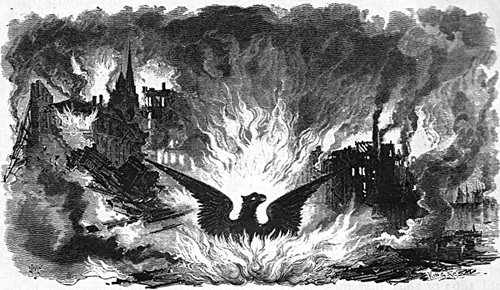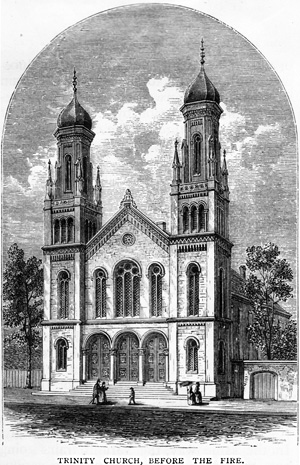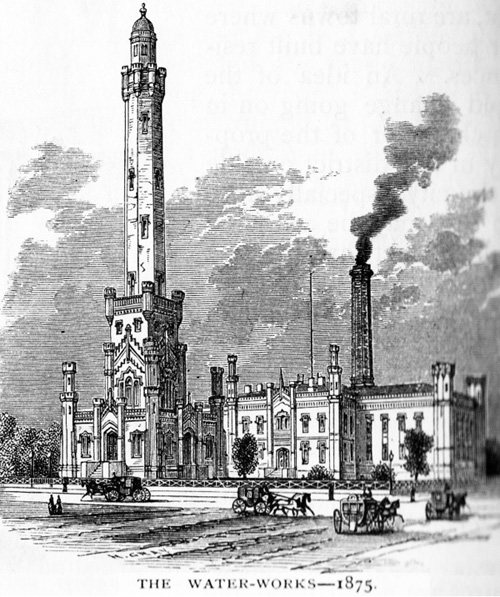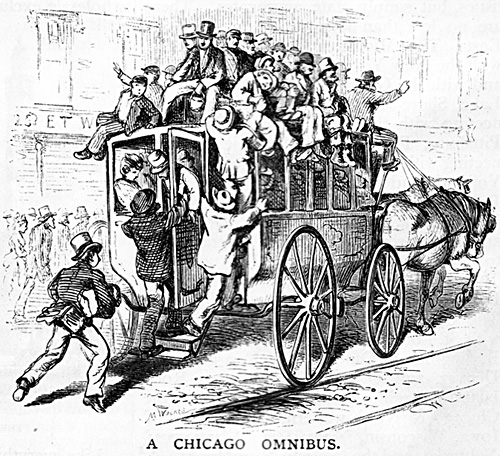After the Chicago Fire
Today, Chicago, after the Fire. The University of Houston's College of Engineering presents this series about the machines that make our civilization run, and the people whose ingenuity created them.
The 1871 Chicago Fire was one of America's famous disasters, right up there with the Galveston Hurricane, the San Francisco Earthquake, and the Johnstown Flood. But, wait a minute. Here's an issue of Century Magazine, Four years after the fire, and a long article about Chicago gives it scant mention.
A small cartoonish drawing shows a phoenix rising from a backdrop of burning buildings. And the fire appears as a kind of temporal benchmark throughout the article. We see a drawing of a building "before the fire," or reference to construction "after the fire". But that's all.

The fire claimed some 300 lives and 34 square blocks. Compare that with some ten thousand who would later die in Galveston, three thousand in San Francisco, two thousand in Johnstown. In fact, another fire took place in Peshtigo, Wisconsin, the same day as the Chicago fire. It killed 1200 people.
The Chicago fire was less than it might seem in the legends that surround it today. And this article treats it like a mere bump on the road. It includes statistics that show the population of Chicago rising continuously from some 4000 in 1832 to almost a half million. The population increased by sixty thousand in the two-year period that included the fire.
 Chicago was a city of tremendous energy in 1875 -- a city where things got done right now, a major commercial crossroads. The freedom of the Wild West and sophistication of the settled East lived side by side. The author is fascinated by the huge presence of Churches and the large number of unbelievers. The city has repealed its blue laws. Belief and unbelief coexist without colliding.
Chicago was a city of tremendous energy in 1875 -- a city where things got done right now, a major commercial crossroads. The freedom of the Wild West and sophistication of the settled East lived side by side. The author is fascinated by the huge presence of Churches and the large number of unbelievers. The city has repealed its blue laws. Belief and unbelief coexist without colliding.
We read how the Chicago River runs through the middle of the city dumping sewage into its Lake Michigan drinking water source. Engineers responded by creating a system to draw water from much further out in the lake. The author doesn't know that they will soon dredge the river so as to completely reverse its flow. Today, it runs inland from the lake instead of into it.
Still greater change lay in Chicago's near future. The vast energy of the city has just begun its work. Now that its old architecture had been cleansed by fire, it was poised to create the modern steel-framed building and the skyscraper.
Cities are fine places when they're not yet driven by old ideas and old power structures -- when they still express the pure energy of their people. The Chicago in this article feels like Houston, Texas, today. A strange poem appears just after the article. The title is A Dead Heart. The last two lines read,
It has forgotten years and years ago
The fiery rapture that once filled its heart.
Cities find that fiery rapture now and then. Chicago did; and so has Houston. And I'm hoping we'll keep that verve and energy for a very long time.
I'm John Lienhard at the University of Houston, where we're interested in the way inventive minds work.
J. W. Sheahan, Chicago. Scribner's Magazine, Sept, 1871. pp. 529-551. All illustrations here are from this source.
For more on Chicago of this period, see J. H. Lienhard, Inventing Modern: Growing up with X-Rays, Skyscrapers and Tailfins. (New York: Oxford University Press, 2003): Chapt. 6.
For a long time only 6000 deaths were attributed to the Galveston Hurricane. That estimate has been substantially emended upward since then -- to at least 8000.
The poem, A Dead Heart was by Mary L. Ritter, a minor poet best known today for a few poems published in magazines of the latter 19th C.

